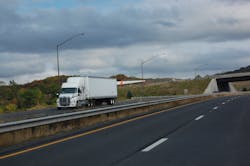Among the “Most Wanted,” a focus on the human factors in transportation safety
The National Transportation Safety Board (NTSB) released its “10 Most Wanted List” of desired transportation safety improvements for 2017 and 2018 this week – a list that that will now be proffered every two years instead of on an annual basis, according to comments made by Christopher Hart, the organization’s chairman, during a press conference yesterday.
Hart pointed out that though NTSB cannot require the transportation industry to take action on its “Most Wanted” list – a list the agency has been compiling since 1990 – he dubbed it a “roadmap” built upon the lessons learned from NTSB crash investigations, representing actions which, if taken, would reduce property damage, prevent injuries, and save lives in all modes of transportation.
And while Hart emphasized that transportation as a whole “has become much safer” in the U.S. is much safer over the now 50 years NTSB has been on the scene, there’s been slippage in the numbers of late – especially in terms of highway fatalities.
“From 2014 to 2015, according to the National Highway Traffic Safety Administration (NHTSA), highway fatalities increased by 7.2%; the largest percentage increase since before the NTSB was founded,” he stressed in his prepared remarks. “Worse yet, early estimates show a 10.4% increase in motor vehicle deaths for the first half of 2016 versus the first half of 2015. Tragically, for the first time since 2008, more than 35,000 people died on our roads.”
[Highway crashes also come with a huge price tag, too, as this story illustrates.]
Before this turn for the worse, Hart noted that progress on highway safety “looked good,” with fatalities generally declining for decades.
“This setback is a reminder that safety is not a destination, but a continuing journey, and our efforts to improve safety must never stop,” he explained. “It takes a concerted and continuing effort by industry, government, and private citizens to save lives.”
To that end, here is what NTSB believes are the top 10 “Most Wanted” improvements to transportation that should help reverse this current deadly trend:
- Eliminate Distractions
- Reduce Fatigue-Related Accidents
- Prevent Loss of Control in Flight in General Aviation
- Improve Rail Transit Safety Oversight
- End Alcohol and Other Drug Impairment in Transportation
- Increase Implementation of Collision Avoidance Technologies
- Expand Recorder Use to Enhance Safety
- Require Medical Fitness
- Strengthen Occupant Protection
- Ensure the Safe Shipment of Hazardous Materials
As usual, there’s a big emphasis on technology within NTSB’s “most Wanted” list, with further use of collision-avoidance technology – especially for motorized vehicles – encouraged.
Yet note the preponderance of “human factor” elements within the “Most Wanted” list for 2017-2018 – especially the focus on medical fitness, fatigue, alcohol/drug impairment, and distraction.
The National Safety Council, for one, thinks this focus is critical as NSC President and CEO Deborah A.P. Hersman – herself a former NTSB chair – noted that they are major “proximate causes” and “contributing factors” to thousands of fatalities in transportation annually.
“As 95% of transportation deaths occur on our nation’s roadways, if left unchecked, these issues will continue killing thousands of roadway users each year,” she explained. “Although our vehicles are safer than ever before, according to NHTSA, human error is responsible for 94% of crashes.”
I talked with Hersman last week about the many human factors involved in highway crashes, with her noting that there’s rising worry in safety circles about drug impaired driving – especially in light of the push by many states to legalize marijuana, though that is not the only drug of concern.
“Marijuana is of course a huge issue,” Hersman told me. “There’s a lot of comparison with alcohol [legalization] but it’s really not the same. For example, the effects of alcohol have been widely studied; we know the BAC [blood alcohol content] impairment levels for men and women.”
Marijuana, however, offers a different challenge as it can be smoked or ingested, with the potency of the marijuana being grown and sold today – in terms of its active ingredient, THC – much greater than the marijuana grown and sold four or five decades ago.
“What constitutes impairment? What constitutes a ‘cut off point’ in marijuana use before operating a motor vehicle?” Hersman asked. “The drug also affects people differently and it packs more of a punch today.”
Then there is the opioid crisis; a far scarier drug problem to Hersman’s mind that the widespread legalization of marijuana, in terms of impaired driving.
“We now know there’s a high risk of abuse; these drugs [opioids] are dangerous because they are prescribed by a doctor so many think they are OK – that they are safe,” she said.
In Hersman’s view, a truck driver is far more likely to be at risk of opioid addiction versus marijuana abuse because the truck driver population is older and the nature of the work can lead to injuries.
It just goes to show that technology cannot solve everything, especially when it comes to issues intrinsically wrapped up in human biology.


